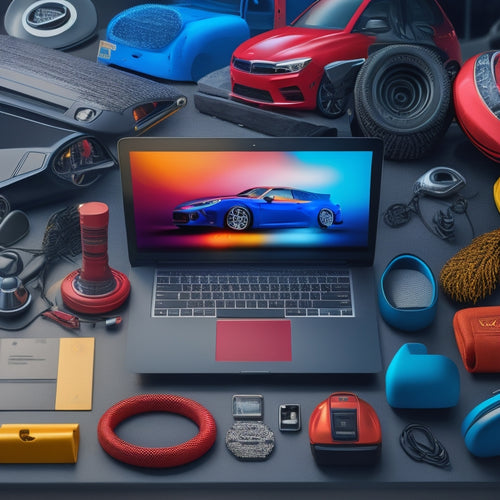
5 Tips to Optimize Your Home's Energy Harvest
Share
You can boost your home's energy harvest by up to 20% by identifying and addressing common efficiency-draining issues. Start by monitoring your energy production in real-time to pinpoint areas for improvement. Regularly inspect your panels for debris and clean them gently to guarantee maximum energy production. Fine-tune your panel angles and directions to maximize sunlight absorption. Reduce shading by trimming trees nearby, and perform regular inverter checks to make sure smooth operation. By following these tips, you'll be on your way to maximizing your energy production - and there's even more to explore to get the most out of your system.
Key Takeaways
• Monitor energy production in real-time to identify areas for improvement and maximize energy harvest.
• Regularly inspect and clean solar panels to ensure optimal energy production, removing dirt, leaves, or obstructions.
• Fine-tune panel angles and directions to optimize sunlight absorption, considering seasonal adjustments and removing obstructions.
• Trim trees near solar panels to minimize shading, pruning strategically to avoid harming tree health and removing branches within 10-15 feet of panels.
• Perform regular inverter checks to ensure smooth and efficient operation, monitoring temperature, fault detection, and DC input voltage.
Monitor Your Energy Production
By tracking your energy production in real-time, you can identify areas for improvement and maximize your energy harvest. It's like having a personal energy coach, minus the annoying motivational speeches. With real-time monitoring, you'll be able to pinpoint when your energy production dips or surges, and make adjustments accordingly.
This is especially useful for homeowners who've variable energy needs, like those with electric vehicles or power-hungry hobbies.
Energy tracking is a game-changer for homeowners who want to optimize their energy harvest. By keeping an eye on your energy production, you can identify patterns and make adjustments to maximize your energy output.
For instance, if you notice that your energy production tends to dip during peak sunlight hours, you can adjust your panel angles or clean your panels to boost energy production. With real-time monitoring, you'll be able to make data-driven decisions to optimize your energy harvest and save some serious cash on your energy bills.
Inspect Panels for Debris Buildup
Every few months, inspect your solar panels for debris buildup, as dust, leaves, and other obstructions can greatly reduce their energy output. To guarantee optimal energy production, make sure your panels are free from debris.
If you're comfortable with roof accessibility, you can inspect your panels yourself. Otherwise, consider hiring a professional to do the job. When inspecting, look for dirt, leaves, or other obstructions blocking sunlight from reaching the panels.
A simple way to remove debris is through panel washing. Use a soft-bristled brush or a specialized panel cleaning tool to gently sweep away dirt and debris. For tougher grime, mix a solution of mild soap and water, and use a soft cloth to wipe down the panels. Avoid using harsh chemicals or abrasive materials that can scratch the panels.
Optimize Panel Angles and Directions
You've confirmed that your solar panels are free from debris, now it's time to optimize their angles and directions to maximize energy production. Think of it as fine-tuning your panels to soak up the sun's rays like a pro.
First, consider seasonal adjustments. As the sun's position changes throughout the year, your panels should too. Make adjustments to account for the changing angle of the sun, especially during winter and summer solstices.
Next, take a closer look at your rooftop mapping. Identify any areas that might be obstructing sunlight and adjust your panels accordingly. Remember, every degree counts when it comes to energy production.
Reduce Shading With Tree Trimming
Trimming trees near your solar panels is vital to minimize shading, which can greatly reduce energy production. You don't want those hard-earned rays blocked by branches, do you? By keeping your trees in check, you'll maximize your energy harvest and keep your wallet happy.
To get started, assess the trees surrounding your solar panels. Identify which branches are causing the most shading and prioritize those for trimming.
It's important to prune strategically, as improper pruning can harm tree health. Consider hiring a professional arborist if you're unsure about the best pruning strategies for your trees.
When pruning, aim to remove any branches that are within 10-15 feet of your solar panels. This will ensure minimal shading and peak energy production.
Perform Regular Inverter Checks
Regularly inspecting your inverter's performance helps identify potential issues before they impact your energy harvest. Think of it as a regular health check-up for your inverter, guaranteeing it's running smoothly and efficiently. By doing so, you can prevent minor issues from becoming major problems that affect your energy production.
Here are some key things to check during your inverter inspection:
-
Monitor inverter temperature: High temperatures can reduce your inverter's lifespan. Make sure it's running within the recommended temperature range.
-
Check for fault detection: Identify any error codes or alerts that may indicate a problem with your inverter. Addressing these issues promptly can prevent downtime and energy loss.
-
Verify inverter DC input: Ensure the DC input voltage is within the recommended range to prevent damage to your inverter.
- Inspect cables and connections: Check for signs of wear, corrosion, or damage that could disrupt energy production.
Frequently Asked Questions
Can I Install Solar Panels on a Metal Roof?
You can install solar panels on a metal roof, but make sure metal compatibility and minimize roof penetrations to avoid leaks; use a qualified installer to secure the panels without compromising your roof's integrity.
How Often Should I Clean My Solar Panels?
"You should clean your solar panels every 6-12 months to prevent dust accumulation, which can reduce panel efficiency by up to 25%! Don't let dirt dim your energy harvest - grab a soft brush and get scrubbing!"
Do Solar Panels Work During a Power Outage?
During a power outage, you're stuck in the dark unless you have a backup power system, like a battery bank, to store excess energy, giving you grid independence and keeping the lights on when the grid doesn't.
Can I Use Solar Panels With a Septic System?
You're wondering if solar panels can coexist with a septic system? Absolutely! Since septic systems rely on wastewater treatment and groundwater recharge, solar panels won't interfere with these processes, and you can enjoy clean energy and clean water!
Are Solar Panels Damaged by Hail?
You're wondering if hail will ruin your solar panels? Good news! Most panels are built with hail resilience in mind, boasting impressive weather durability. They can withstand hail storms up to 1 inch in diameter at 50 mph.
Related Posts
-

Why You Need a Phone Mount for Navigation
When you're on the road, a reliable phone mount is not just a convenience, it's a safety necessity that helps you mai...
-

Top 10 Tips for Buying Car Accessories Online
When purchasing car accessories online, you should take proactive steps to avoid low-quality or incompatible products...
-

Safely Staying on Course: 5 Essential Lane Tips
You're about to take your driving skills to the next level by mastering the art of staying in your lane. First, inves...


